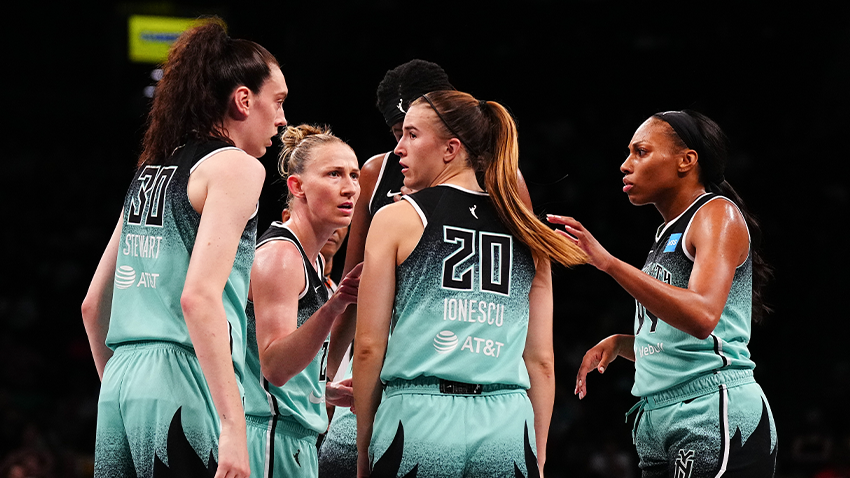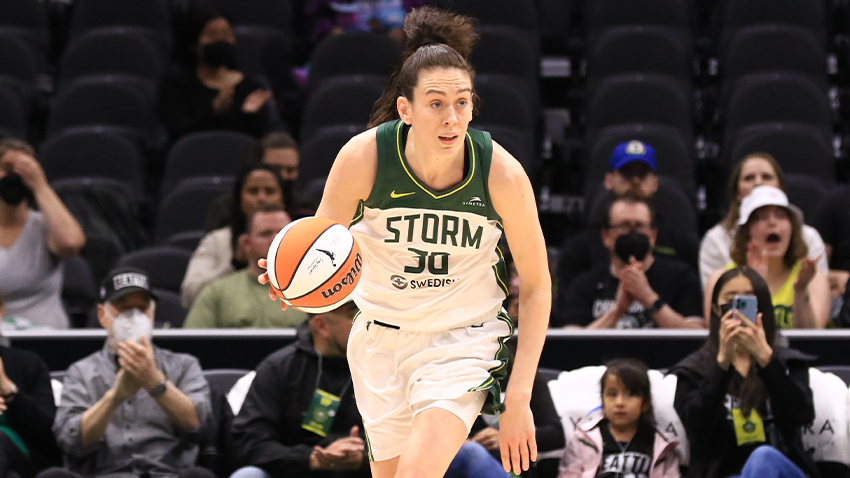New York Liberty Defense: The Blueprint

After one of the loftiest and most substantial single off-season roster overturns we’ve seen in a quarter century of the WNBA, the New York Liberty are embracing the process of the regular season.
The offense has hummed early, flashing brilliance for stretches when five All-Star-worthy players click as one. The ball pops, mismatches are eviscerated, coverages are bludgeoned, and it’s hard not to grin, witnessing synergy and meshed talent.
New York’s starting lineup (Courtney Vandersloot/Sabrina Ionescu/Betnijah Laney/Breanna Stewart/Jonquel Jones) is outscoring the opposition by 16.6 points per 100 possessions, according to PBP stats.
They’re registering a 120.9 offensive rating over roughly 100 minutes of play: No lineup that’s played 40 minutes or more this season across the league has surpassed that mark.
The Liberty sit 5th in defense, a stone’s throw away from third as of today, and collectively, the team sees their defense as a skeleton key, capable of unlocking a multitude of doors for them as they find more consistency.
“We do have a good sense of defensive awareness and understanding of who we’re guarding and where we are, our length… so as we continue to grow, not being uncomfortable in these situations of me or JJ being on a guard, and Sloot and Sabrina being on a post. Just continuing to work and play through that,” says Stewart on New York’s defensive principles.
Loaded with length and positional versatility, the Liberty employs a switch-heavy scheme. They’ll mix in additional ball pressure (traps/hedges) depending on who they play, but typically, New York is playing man-to-man defense, and switching when screened out. They’ll show and recover with their bigs, using their length and mobility to try and prevent dribble penetration.
“You just gotta stay fluid… what’s out there, and what do we need? We’re very versatile and go with what we think works at that time. We have our core values, so I’m very consistent with how we play, and then it’s just adding tweaks here and there,” says Liberty Head Coach Sandy Brondello.
Deflections are paramount, something the coaching staff harps on and tracks, and something they want to see more of moving forward. It’s a gauge of activity as well as disruption of an offense. As Brondello mentioned, consistency and repetitive ability to make things difficult are what sets apart good and great defenses.
Brondello wants to continue sprinkling in more and more spurts of aggression, and it’s going to take time as they keep raising their baseline during the summer. The Liberty relish having the longest regular season in league history so they can tinker and adapt, honing themselves through more and more game reps as a unit.
Stewart is a perennial Defensive Player of the Year candidate. Jonquel Jones is one of the best rim protectors in the game. Kayla Thornton was a vital addition to the wing rotation as one of the better perimeter defenders in the league.
“We have versatility,” says Thornton.
“We’re all able to switch, so it makes it a little easier, but also having the mindset of being able to guard one on one when it’s needed.”
Every player in sync is essential, but everyone on the Liberty staff and roster issues a similar thought: Betnijah Laney is the key, the engine, and the heart of their defense.
Laney has quick feet, an incredibly solid base, a long wingspan with active hands, and good instincts. Automatically, that makes her a rare defender, someone who can credibly cover guards through screening actions, wings in isolation, and switch onto bigs in the post without ceding a mismatch. Many players have theoretical versatility, but Laney has the acumen and consistency to check the box as effectively versatile.
“She’s given the task most nights of guarding the other team’s best player… if you’ve been on the other side of it, it’s tough, because she has size and she has physicality,” says Stewart of Laney.
Jewell Loyd is having an All-W-worthy season, and watch how Laney makes her work.
She denies Loyd the screen as the Storm set staggered screens for her, careening Laney into the first screen, then flies up to come off the second screen. Laney stays attached and tightly squeezes the gap to slink around Mercedes Russell.
Even if the pass is a bit more on target, Laney stays in front.
Jewell tries to work back to the slot, Laney slides, and Loyd backtracks. Laney slides again and cuts her off, and Loyd returns to the screen where Laney and Jones converge and force the jump ball.
“I’m just trying to be the best me, whatever my role is,” says Laney
“It’s just being aggressive. It’s hard to screen somebody who’s always moving and active, otherwise, you’re gonna get a moving screen trying to catch me. It’s more so just making sure I’m engaged in every way.”
Engagement and activity define what Laney has brought and will continue to bring for the Liberty on the defensive end.
That repetitive ability to make things difficult for the opposition is what makes Laney special as a defender. It’s not necessarily about getting the stop outright, it’s about setting it up, making it possible for New York’s backline to overwhelm, and dragging shotmakers and playmakers deeper into the shot clock.
Laney has been aggressive with pick-up points, forcing ball-handlers to feel her presence often as soon as they pass half-court. She makes it a war of attrition.
She staples herself to Marina Mabrey, making the hand-off a little harder, making her work just to move. Laney technically gets beat off the dribble, but it’s ok. That’s the point of what the Liberty are doing in a sense, they’re able to put on the pressure and then late-switch (a switch once a defender is beaten off the dribble) with their frontcourt to stifle possessions and squeeze gaps.
Mabrey gets her shot off, but the shot itself and the process to get there is a long-term win in the game for the Liberty defense.
“Her role offensively is probably not as high as what she’s used to, but she’s still so important for our overall game. We want her to be Defensive Player of the Year, that’s how we’re built,” says Brondello.
“You need those kinds of players. Who’s the engine that gets everyone going? B is that.”
WNBA reporter Mark Schindler writes a column on WNBA.com throughout the season and can be reached on Twitter at @MG_Schindler. The views on this page do not necessarily reflect the views of the WNBA or its clubs.







,xPosition=.5,yPosition=.5)
,xPosition=.5,yPosition=.5)
,xPosition=.5,yPosition=.5)
,xPosition=.5,yPosition=.5)